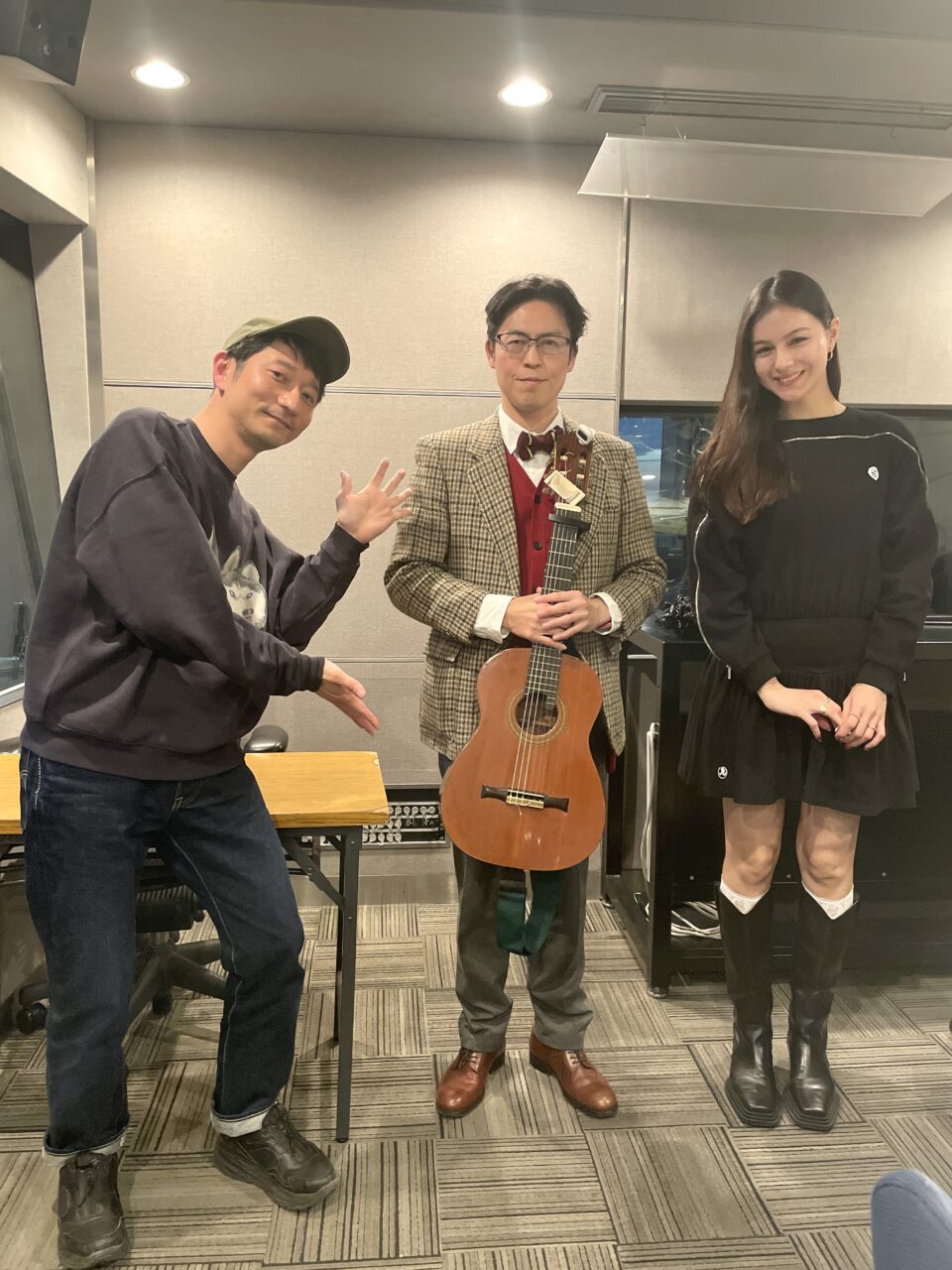A circle of friends connected by goo touch! The “FIST BUMP” corner of the radio program “GRAND MARQUEE” features people who live and enjoy Tokyo in a relay format.
On January 2, Paris Nakayama, a strolling guitarist, will appear. We asked him about his activities as a strolling guitarist(Nagashi), the history of Nagashi, the “Heisei Nagashi Association,” which he founded, and the “All Japan Nagashi Association,” which was formed by three groups of nagashi.
INDEX
“Nagashi” style of performing at restaurants in response to requests
Celeina (MC): Today, we have a recommendation from the program, Paris Nakayama, who is a strolling guitarist(Nagashi).
Takano (MC): What exactly is the Nagashi?
Paris: I don’t know exactly, but a Nagashi is a person who comes to bars and other places at night and plays in response to requests from customers. They have been around since the Showa period (1926-1989), and it seems to be traditional to play guitar, accordion, or violin.
Celeina:Paris Nakayama-san, I understand that you play the guitar. Where do you usually perform?
Paris:I started playing at Kameido Yokocho in Kameido, and have been at Ebisu Yokocho in Ebisu since 2008. I am also active there and go to various places such as Harmonica Yokocho in Kichijoji and Tamai in Mizonokuchi.
Celeina:How often are you active?
Paris:Four times a week, but sometimes I go five or six times if there is a lot of activity.
Takano: I am interested in the Nagashi system. I have an image that Nagashi starts guerrilla style, but how does it work?
Paris: I think it is possible to do it guerrilla style, but we ask the stores for permission beforehand. We do it so that it is a win-win situation for both us and the store. In most cases, guerrilla activities do not go well. However, I think there is a sense of guerrilla-like beginning for the customers.
Takano: It is true, because the playing starts all of a sudden. But the audience gets really excited, too. Moreover, you are able to answer requests.
Celeina:How many songs do you have in your repertoire?
Paris: Right now, I have about 2,000 songs, officially.
Takano: 2000 songs! What kind of songs, for example?
Paris:It depends on the age group, but the standard ones that all generations know are Spitz, Southern All Stars, and Yumi Matsutoya. People of all generations love them, so I sometimes sing them several times a day.
Celeina:By the way, do you only go to one restaurant a night as a Nagashi? Or do you go to several?
Paris:On many days, there are more than a dozen stores in one area, so we make a circuit and visit many different stores. After performing at the store that requested us, we go to the next store.
INDEX
Requests to the Nagashi is selected from a pamphlet
Celeina:I have never made a request to a Nagashi before, but I would like to do so in the future, so please tell me about the etiquette.
Paris:I myself had never met a Nagashi before I became a Nagashi, and I started my activities just by watching and imitating them. Basically, Nagashis have a kind of pamphlet, and I have a pamphlet too.
Celeina:We have Paris’s pamphlet in the studio.
Paris: There is someone in the store with a guitar, so I can get a little bit of attention, so I give them the pamphlet as if to say, “I am answering your requests,” and if they have a song they like, they can choose it.
Celeina: I see.
Paris:After the performance, if they are satisfied or happy with the performance, we receive a tip.
Celeina: We can pay the tip with electronic money such as PayPay.
Takano: That’s very modern.
Paris: Some people don’t carry cash these days.
Celeina:I appreciate it. And in the pamphlet, there is also your social networking information. If I check your social networking site, can I know where you will be today?
Paris:Yes. I am giving out information.
Takano: It is possible to go to a restaurant just to see Paris-san, isn’t it?
Paris: If possible, that would be better for the restaurant.
INDEX
From a repertoire of 2,000 songs, he performs in the studio.
Takano: And the song list in the pamphlet is very diverse.
Celeina:There are some recent songs.
Takano: There is “Pretender” by Official Hige Dandism, “Marigold” by Aimiyoon, “Dried Flower” by Yuri, and so on.
Paris:When the musician perform at the Kohaku Uta Gassen, I often get more requests about that musician from January.
Takano: By the way, if I make a request now, can you do it here in the studio?
Paris: Yes. There is a pattern that I often start playing while talking like this.
Takano: Ms.Celeina, which song would you like?
Celeina: “Ito” by Miyuki Nakajima caught my attention, so I would like to request this one.
Paris: I have been playing the Nagashi for 15 to 6 years, and this song has been very popular since the beginning. Now, let me play “Ito”.
(Performs “Ito” by Miyuki Nakajima)
Celeina: Paris Nakayama-san played “Ito” by Miyuki Nakajima.
Takano: You really have a wonderful guitar and singing voice. It was a luxury to be able to listen to them from this distance.
Celeina: The classical guitar tone and vibrato in your voice really worked well.
Paris: Thank you very much.
Celeina: Today, Paris-san is wearing a jacket and bow tie, which matches the atmosphere very well. Do you usually wear this outfit when you go to the Nagashi?
Paris: I wore it today so that it would look good, but it depends on the day. But I usually wear a bow tie.
INDEX
Three Nagashi organizations established the “All Japan Nagashi Association” to promote the historical Nagashi culture.
Takano: I am also interested in the history of Nagashi. When did it start?
Paris: There are two theories. The first is the Shinnai-nagashi that existed in the Edo period. A man named Shinnai-san, who played the shamisen as a musical accompaniment for Kabuki performances, originally played it on stage, but he walked to a brothel district and started playing the shamisen. He became very popular, and the story was passed down from generation to generation in the form of the “Shinnai-nagashi” style. It was like waiting outside to receive a request from a room in the brothel and being told to come up and play. That seems to be the first use of the word “nagashi.
Secondly, there was a man in the Meiji era named Soeda Azenbo, who sang ironically about the contents of newspapers and appealed to the public outside. It seems to have started as a social movement.
Takano: I didn’t know there was such a history. And I heard that last year you also created a Nagashi group.
Paris:First of all, in 2014, I created a Nagashi group called “Heisei Nagashi Kumiai,” which is a music-centered Nagashi group with about 65 members. Then, last year I created the “All Japan Nagashi Association”.
Actually, there are three major Nagashi groups in the Kanto area: the first is “Kashiwa Nagashi,” a group that performs in Kashiwa, the second is “YOI x Gei,” a group that performs mainly in areas such as Norenmachi and Yokocho, and the third is “Heisei Nagashi Association,” which I created, and which performs in Ebisu Yokocho and Kabukicho Tower. The third group is “Heisei Nagekyo Association,” which I created and which operates in Ebisu Yokocho and Kabukicho Tower.These three groups came together to form the association with the aim of expanding the industry even further.
Takano: How many people are in the association as a whole?
Paris: About 200 people. But not all of us are doing music-related entertainment. We also do street performances, comedy, magic, and recently, portraits. I think we are also going to start offering massages.
Takano: Massage, too! That’s nice.
Celeina: It makes drinking more fun. Lastly, what do you find interesting about Nagashi compared to so-called “live” performances?
Paris: I think it’s the fact that I can’t read the audience. There is no scheduled harmony, so even if I am a veteran performer, I am going to meet people I have never met before, and it is an away-from-home place. It’s very realistic to see the person I am meeting be extremely happy with my performance. Personally, I think that is what I enjoy about it.
Takano: It’s a once-in-a-lifetime encounter, isn’t it?
Celeina: Now, “FIST BUMP” is a circle of friends connected by “goo touch,” and we are asking you to introduce us to some of your friends.
Paris:Mr. Kenji Takahashi who is the founder and editor-in-chief of a local web newspaper called “Ebisu Shinbun” (Ebisu Newspaper).
Celeina:In a word, what kind of person is he?
Paris: I guess he is a cheerleader for the city of Ebisu.
Celeina:Thank you very much. Tomorrow, I will connect to Mr. Kenji Takahashi, the editor-in-chief of “Ebisu Shinbun”. “FIST BUMP”, today we welcome Paris Nakayama, a strolling guitarist(Nagashi). Thank you very much.

GRAND MARQUEE

J-WAVE (81.3FM) Mon-Thu 16:00 – 18:50
Navigator: Shinya Takano, Celeina Ann






















